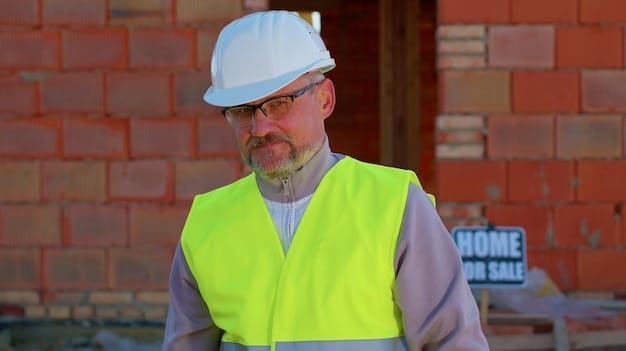Housing Market Update: New Construction Starts Surge by 7% Nationwide

The US housing market experiences a notable upswing as new construction starts increase by 7% nationwide, signaling potential growth and opportunities for both builders and prospective homeowners amidst fluctuating economic conditions.
The latest housing market update reveals a significant increase in new construction starts, jumping by 7% across the nation. What does this mean for potential homebuyers and the overall economy? Let’s dive into the details.
New Construction Starts: A National Overview
The housing sector is a critical component of the US economy, and recent data indicates a positive trend. New construction starts have seen a substantial increase, reflecting renewed confidence among builders and potential growth in the market. Let’s explore what’s driving this surge and its broader implications.
Key Factors Driving the Increase
Several elements contribute to the rise in new construction starts. Understanding these factors provides valuable insight into the dynamics of the housing market.
- Rising Demand: Increased demand for housing, particularly in suburban and rural areas, is a major driver.
- Low Interest Rates: Historically low interest rates have made mortgages more affordable, encouraging construction.
- Government Incentives: Various government programs and incentives support new housing developments.
These elements combined create a favorable environment for construction companies to initiate new projects, thus impacting the overall housing supply.

Regional Variations in Housing Starts
While the national average shows a 7% increase, regional data tells a more nuanced story. Housing starts vary significantly across different parts of the United States, reflecting local economic conditions and demographic trends. Let’s examine some specific regions and their unique situations.
Northeast: A Slow but Steady Climb
The Northeast region has seen a more gradual increase in new construction starts compared to other areas. Factors such as higher land costs and stricter zoning regulations contribute to this slower pace.
South: Leading the Way in New Builds
The Southern states are leading the nation in new construction starts. Population growth, favorable tax policies, and relatively lower land costs make this region attractive for developers.
- Texas: A booming economy and large population have fueled housing demand in Texas.
- Florida: Attracts homeowners with its warm climate and growing job market.
- Georgia: Affordable housing options and a business-friendly environment are driving construction.
These regional variations highlight the importance of considering local factors when analyzing the overall housing market.
Economic Impact of Increased Construction
An increase in new construction starts has significant ripple effects throughout the economy. From job creation to increased consumer spending, the benefits are widespread. Let’s analyze how this activity drives economic growth and supports related industries.
Job Creation: Building the Future
The construction industry is a major employer, and an increase in new projects naturally leads to job creation. Construction workers, architects, engineers, and project managers all benefit from this boost in activity.
Supply Chain Benefits
Increased construction benefits various industries in the supply chain. Lumber, concrete, plumbing, electrical, and roofing companies all see a rise in demand for their products and services.

Challenges and Obstacles in the Housing Market
Despite the positive increase in new construction starts, the housing market still faces several challenges. Material costs, labor shortages, and regulatory hurdles can all impact the pace of development. Let’s discuss these obstacles and their potential solutions.
Rising Material Costs
The cost of lumber, steel, and other building materials has been volatile, impacting project budgets and timelines. This makes it more difficult for developers to predict costs and can lead to project delays or cancellations.
Labor Shortages
A shortage of skilled labor in the construction industry is another major challenge. Finding qualified tradespeople, such as carpenters, electricians, and plumbers, can be difficult, especially during periods of high demand.
- Training Programs: Investing in vocational training programs can help address the labor shortage.
- Immigration Policies: Streamlining immigration policies for skilled workers can provide additional labor resources.
- Automation: Adopting new technologies and automation can increase efficiency and reduce labor needs.
Overcoming these obstacles is crucial for sustaining growth in the housing market and ensuring that new construction meets the rising demand.
Future Outlook and Predictions
Looking ahead, the future of the housing market will depend on various factors, including economic growth, interest rate policies, and demographic trends. What can we expect in the coming months and years? Let’s explore some possible scenarios.
Interest Rate Impact
Changes in interest rates can significantly impact housing affordability and demand. Higher rates can cool down the market, while lower rates can stimulate activity.
Demographic Shifts
Demographic trends, such as the aging population and migration patterns, will continue to shape housing demand. Understanding these shifts is essential for developers and policymakers.
Government Policies and Regulations
Government policies and regulations play a crucial role in shaping the housing market. Zoning laws, building codes, and tax incentives can all influence the pace and type of new construction. Let’s examine some key policies and their effects.
Zoning Regulations
Zoning laws determine what type of construction is allowed in different areas. Relaxing these regulations can encourage more housing development, especially in densely populated areas.
These policies collectively impact the availability and affordability of housing, shaping the overall market dynamic.
| Key Point | Brief Description |
|---|---|
| 📈 Increase in Construction | New construction starts increased by 7% nationally, enhancing housing supply. |
| 🏘️ Regional Variations | The South leads in new builds; The Northeast sees a more gradual increase. |
| 👷 Economic Impact | Increased construction leads to job creation and benefits the supply chain. |
| 🧱 Challenges | Rising material costs and labor shortages pose challenges to builders. |
FAQ
▼
The increase is driven by rising housing demand, historically low interest rates, and government incentives that encourage new housing developments.
▼
The Southern states are leading the nation in new construction starts due to population growth, favorable tax policies, and affordable land costs.
▼
Increased construction creates jobs, boosts demand for building materials, and stimulates spending in related industries, contributing to overall economic growth.
▼
Builders face rising material costs, including lumber and steel, and labor shortages of skilled tradespeople, which affect project timelines and budgets.
▼
Government policies, such as zoning regulations, building codes, and tax incentives, significantly impact the pace, location, and type of new housing construction.
Conclusion
In conclusion, the 7% increase in new construction starts nationwide signifies a positive shift in the housing market, with regional variations reflecting diverse economic conditions. While challenges such as rising material costs and labor shortages persist, strategic solutions and policy adjustments can help sustain this growth and meet the evolving housing needs of the population.





